- Iran has refused to allow International Atomic Energy Agency (IAEA) inspectors to visit the site of the suspected explosives chamber at the Parchin military complex (PMC) pending agreement over the modalities of cooperation.
- Other circumstantial indicators, acquired technical expertise and behavioural precedents appear to reinforce suspicions concerning nuclear-related activities at PMC.
- Recent satellite imagery suggests extensive sanitisation and landscaping efforts around the chamber site.
- Taking these factors into account and based on public-domain sources, Open Briefing concludes it is highly likely that any nuclear-related activities at PMC have been suspended.
- In the interests of regional peace and stability, it is incumbent on Iran to provide conclusive clarifications if it is to establish that nuclear-related weaponisation did not take place at PMC in accordance with its claims.
Background
Located 30 km southeast of Tehran, PMC is a key locus for the research, development and production of military materiel, including conventional munitions and explosives. However, analysts believe that the compound’s isolated northeast also houses a containment chamber (at 35° 33′ 33.22″, 51° 47′ 6.12″) specially designed for high explosive and hydrodynamic tests consistent with a nuclear weapons programme.
According to Western intelligence agencies, the chamber was installed sometime in early 2000 and measures approximately 18.8 m by 4.6 m. Nuclear-related activity allegedly also took place in another building located some 140 m to its north.
A November 2011 report by the IAEA stated that:
A building was constructed at that time around a large cylindrical object at a location at the Parchin military complex. A large earth berm was subsequently constructed between the building containing the cylinder and a neighbouring building, indicating the probable use of high explosives in the chamber. The [IAEA] has obtained commercial satellite images that are consistent with this information.
PMC appears to be run by the Defence Industries Organisation, a subsidiary of the Ministry of Defence and Armed Forces Logistics which also plays a key role in Iran’s centrifuge programme. Accordingly, nuclear-related explosive tests conducted within the compound, if verified, could further challenge Iran’s assertions concerning the purely civilian nature of its nuclear programme.
Consider that Iran is also currently enriching uranium to near military-grade levels, in quantities reportedly inconsistent with the number of nuclear power plants currently in operation, and is on track to eventually extract fissile plutonium by reprocessing spent uranium fuel rods at the 40 Megawatt Heavy Water Reactor near Arak (IR-40). Furthermore, Iran has been openly developing delivery systems such as the Shahab-3 medium-range ballistic missile and its variants, usually associated with non-conventional or nuclear warfare.
Weaponisation, including experiments relating to high-explosive initiation systems and the machining of weapons-grade uranium in metal form to fit a missile warhead, is the third component required to turn both fissile material and delivery system into a deployable nuclear weapon. Iran is believed to have conducted nuclear-related weaponisation tests until around 2003, when this was temporarily suspended along with uranium enrichment, though this may have resumed sometime after 2007.
Time-series satellite imagery
In August 2004, the Washington-based Institute for Science and International Security (ISIS) raised the flag on allegations that weaponisation tests had taken place in PMC.
On 13 January 2005, IAEA inspectors visited PMC and were allowed partial access that did not include the specific containment chamber site. During a second visit on 1 November 2005, they collected environmental samples from an area that was not near the chamber site but rather in PMC’s southwest, which the Agency was focusing on at that time. Their requests to access the chamber site since then have been denied. The Iranian authorities have argued that the IAEA’s mandate does not extend thereto because PMC is a purely military facility.
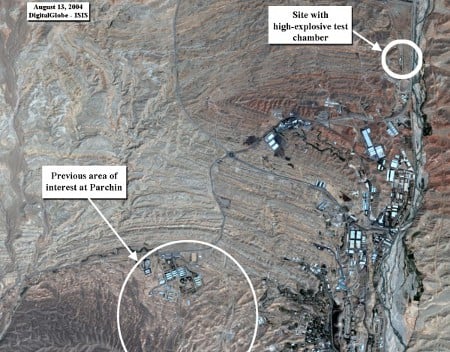
In January 2012, the IAEA notified Iran of the precise location within PMC it wished to inspect. Commercial satellite imagery obtained by ISIS (and reproduced here) then recorded a series of unprecedented and extensive surface activity at the suspected test site:
9 April 2012 showed a stream of liquid (presumably water) originating from either next to or within the suspected chamber, with a number of unknown items lined up outside.
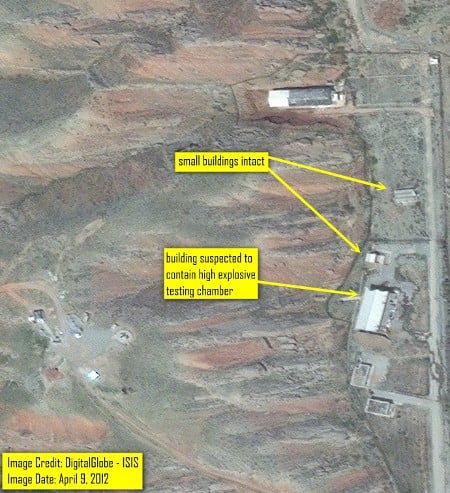

25 May 2012 showed that two buildings to the immediate north of the chamber had been razed, with accompanying evidence of earth displacement and heavy tracked vehicles.
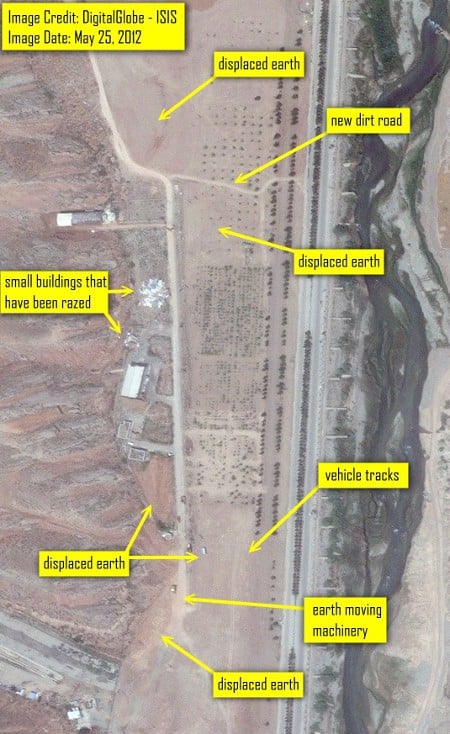
7 June 2012 showed debris from one of the demolished buildings, the removal of the security perimeter and more water runoff from near the suspected chamber.

21 June 2012 showed debris removal from one of the two razed buildings, more earth displacement, and water runoff from an object – probably a water tank – that had been moved to the south of the suspected chamber.
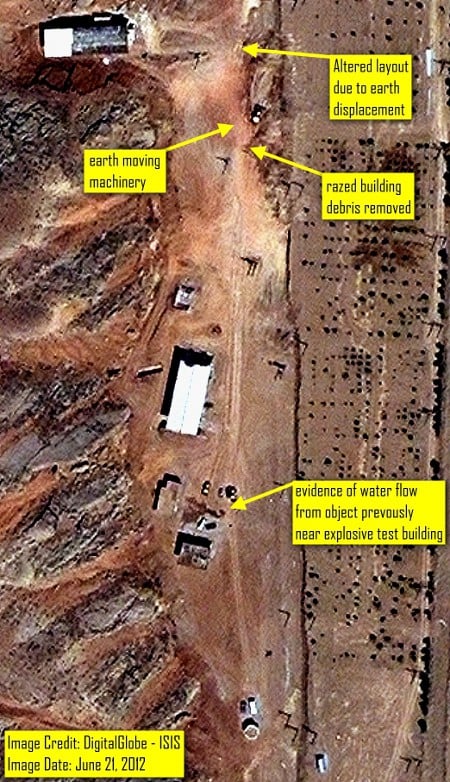
25 July 2012 indicated that extensive demolition and topsoil displacement spread over some 25 hectares of land had been carried out, although the building housing the suspected chamber remained.

15 August 2012 showed pink tent-like material shrouding the suspected chamber and the structure 140 m to its north. (The angularity of both tarpaulins suggests scaffolding beneath according to ISIS.)
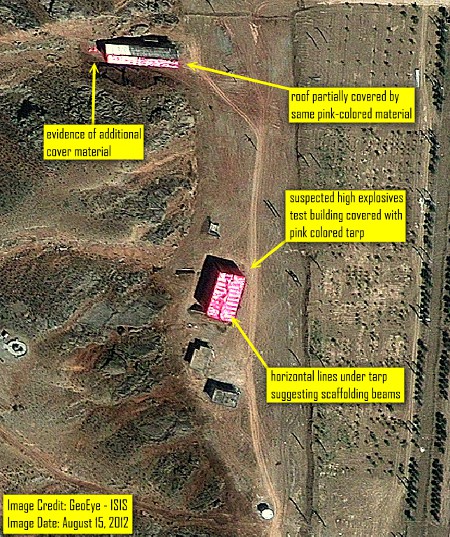
19 September 2012 showed that the tarpaulins had been largely removed.

7 November 2012 showed new or newly painted roofing on the two buildings in place of the previous tarpaulins, a new annex on the northern side of the suspected chamber, and some kind of linear construction along the north-south asphalt axis spanning both buildings. In addition, new equipment and large quantities of new earth have been transported to the site, presumably to replace any previously contaminated topsoil.
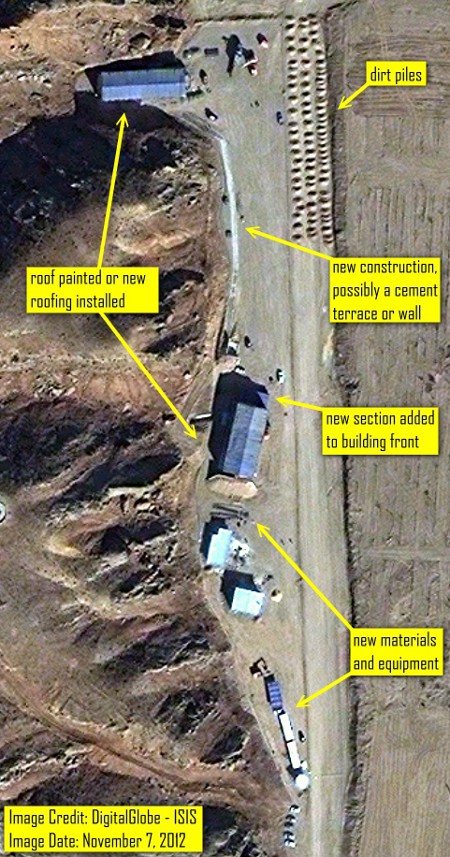
Analysis
The DigitalGlobe and GeoEye imagery from the latter half of 2012 reveals that extensive sanitisation and landscaping efforts have been carried out around the chamber site at PMC. This suggests it is highly likely that any nuclear-related activities at the complex – if such activities have indeed taken place – have been suspended.
PMC lies near the centre of a nuclear controversy with potentially far-reaching implications. Iran, signatory to the Non-Proliferation Treaty and a member state of the IAEA, has repeatedly insisted that its nuclear programme is for civilian purposes only. At the same time, Iran has rebuffed the IAEA’s request to visit the suspected site by conditioning this on an agreement regarding modalities of cooperation, and charging that the IAEA has been infiltrated. To be fair, Iran reserves the right to refuse IAEA access to sites of non-nuclear concern so long as their nature remains beyond dispute. Iran’s leaders, however, bear the onus of addressing persisting concerns especially when these are backed by a growing body of evidence suggesting non-compliance.
Further clues reinforce suspicions of the site’s activities by linking it to an ex-Soviet nuclear explosives expert who worked in Iran from 1996 to 2002, ostensibly to assist the government in the production of industrial nanodiamonds. Vyacheslav Danilenko is believed to have been involved in the chamber’s construction and possibly its subsequent use, a claim supported by his former son-in-law Vladimir Padalko. Moreover, a 2003 book Danilenko authored on the nanodiamond synthesis process describes a high explosives compression chamber very similar to the one in PMC with the capacity to contain up to 70 kg of explosives. To date, Iran has not provided clarifications regarding its relationship with Danilenko.
The IAEA has as well noted the suspected chamber’s suitability for the testing of a certain multipoint (implosion) initiation system believed to be in Iran’s possession (and necessary for the simultaneous explosions required to compress a uranium or plutonium core and attain supercritical mass in a nuclear warhead). This device, which would fit within the estimated dimensions of a Shahab-3 or Sejjil-2 warhead, requires only up to 70 kg of explosives during tests. The suspected chamber may not necessarily have been used to test this device, but it raises further suspicions that Iran has so far done little to dispel.
On 17 September 2012, Fereydoun Abbasi-Davani, the head of Iran’s nuclear agency, admitted that his country had deliberately provided misleading information concerning its nuclear programme in order to “protect” it. In addition, Iran not only failed to declare key nuclear sites such as Arak, Natanz and Fordow until information regarding their existence was leaked, but had fortified the latter two against potential air strikes.
Against this backdrop, it is rather difficult to imagine why else Iran would discreetly sanitise the PMC site following the disclosure of its precise location. Experts argue that sanitisation, if done correctly, can remove trace radiation released during tests, and that even if a neutron initiator had been used – as suggested in the German newspaper Sueddeutsche Zeitung in April 2012 – the residual radiation within the chamber would still not constitute conclusive proof of weaponisation.
Iran’s foreign ministry spokesperson Ramin Mehmanparast has countered with the view that no amount of sanitisation can eradicate radioactive traces. However back in 2004, the Iranian government also partially razed the Lavizan-Shian site in northeast Tehran which for some years housed the controversial Physics Research Centre, believed to be the central player in Iran’s nuclear procurement efforts. Although subsequent environmental samples taken by IAEA inspectors proved negative, the Agency’s November 2004 report also noted that the “detection of nuclear material in soil samples would be very difficult in light of the razing of the site”.
The IAEA has scheduled talks with Iran on 13 December. Discussion concerning PMC is expected to be one of the priorities. If Lavizan-Shian is any guide, IAEA requests to visit the PMC chamber site may only be approved, if ever, when the apparent clean-up concludes. This would equally render the suspension or relocation of any nuclear-related weaponisation activities at PMC logical and therefore highly likely.
There are at least three other possible scenarios worth mentioning.
Firstly, PMC might actually be what Tehran says it is despite the counter-indications. Governments, including those of Russia and China, which have assisted in developing Iran’s nuclear programme, typically deploy triple fencing around their high-security facilities. One would expect Iran to adopt the same practice, and yet satellite photos of PMC only reveal one layer. However, this may mean little if dissimulation was intended.
Secondly, the entire chamber affair could have been intended to create the impression of a more advanced nuclear programme, presumably to boost Iran’s bargaining strength. Yet, this is also less plausible for two reasons: Iran is already on track to master the uranium enrichment cycle, what experts commonly recognise to be the hardest part of a nuclear programme; and the symbolic benefit of such a move is also hardly commensurate with the unprecedented and debilitative economic sanctions that have been imposed in partial response.
Thirdly, PMC may actually be a decoy to deflect attention away from more full-bodied weaponisation tests being conducted elsewhere, including underground.
The recent conversion of nearly half its 232 kg of 20% enriched uranium into fuel plates for medical use may have bought Iran some time from decisive military action. Still, its 20% stockpile is expected to grow since the number of centrifuges being fed gaseous uranium hexafluoride in Fordow is poised to double to 1,400, raising overall production in Fordow and Natanz from 15 kg to 25 kg (the rough requirement for one nuclear device) per month. Unless Iran diverts more of its 20% enriched uranium for civilian purposes in the near future, it could still be edging towards a nuclear “breakout” in Israel’s assessment, thereby accelerating the potential for a hot war.
Open Briefing believes that the Iranian authorities must take substantive measures in order to demonstrate definitive proof of their peaceful intentions and thereby regain the confidence of the international community. Conversely, the P5+1 must also offer Tehran trade-offs that lock in the benefits of cooperation. Although ground inspections are necessary to establish this, Iran should still not be presumed culpable a priori until this is concretely proven. For its part, first clearing the air over PMC by allowing the IAEA access to the suspected chamber site without further delay would be more easily achievable than resolving the deadlock over its uranium enrichment activities.
